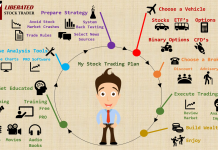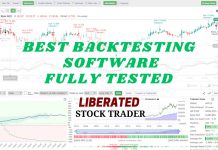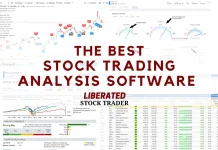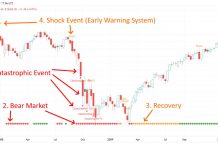Total asset turnover is a financial metric used to assess a company’s efficiency in using its assets to generate sales.
☆ Research You Can Trust ☆
My analysis, research, and testing stems from 25 years of trading experience and my Financial Technician Certification with the International Federation of Technical Analysts.
It is a vital ratio for investors and analysts seeking to understand how well a company utilizes its asset base to produce revenue.
The total asset turnover ratio provides insight into operational performance by comparing the income statement’s sales figures with the balance sheet’s reported assets over a certain period.
Key Takeaways
- Total asset turnover indicates how effectively a company uses assets to generate sales.
- The ratio is calculated by dividing net sales by average total assets.
- This financial metric allows for efficiency comparison across different companies and industries.
Understanding how to compute the total asset turnover can highlight the effectiveness of a company’s management and its operative strategy. The ratio is typically calculated by dividing net sales by average total assets, indicating how many dollars in sales a company generates for each dollar invested in assets. This ratio helps to compare different companies’ use of their assets, irrespective of their sizes or the industries in which they operate.

Understanding Total Asset Turnover
Total Asset Turnover is a critical financial metric that benchmarks how effectively a company utilizes its assets to generate sales.
Definition and Significance
The Total Asset Turnover Ratio is a testament to a company’s efficiency regarding using its total assets to produce revenue. This financial ratio indicates how well a company generates sales from its assets. High turnover ratios often imply that a company uses its assets efficiently to boost sales and grow the business.
Components of Total Asset Turnover
- Net Sales: Net sales are essential for calculating this ratio. This figure is derived from the gross sales minus returns, allowances, and discounts.
- Average Total Assets: The average total assets are calculated by taking the sum of beginning and ending total assets for a period and dividing by two.
The formula for calculating the asset turnover ratio is:
Asset Turnover Ratio = Net Sales / Average Total Assets
This equation underscores the direct relationship between sales efficiency and asset management. Organizations strategically focus on optimizing this ratio to reflect better asset usage and operational efficiency.

Try Powerful Financial Analysis & Research with Stock Rover
Calculating Total Asset Turnover
Understanding how efficiently a company utilizes its assets to generate sales is crucial for investors and analysts. Total Asset Turnover provides this insight by comparing the net sales to the average total assets.
The Basic Formula
The Total Asset Turnover is expressed through a straightforward equation:
Asset Turnover Ratio = Net Sales / Average Total Assets
Net sales reflect a company’s revenue after accounting for sales returns, allowances, and discounts. Average Total Assets are calculated by summing the beginning and ending total assets for a period and dividing by two, reflecting a company’s average investment in assets.
Analyzing Calculation Outcomes
When analyzing the Asset Turnover Ratio, one assesses how well a company uses its assets to produce revenue. A higher ratio implies more efficient asset use, while a lower ratio may suggest the opposite. However, comparing ratios across different industries can be misleading due to varying capital intensities.
Example Calculations
To illustrate, consider a hypothetical firm, Company Z, which reports beginning assets of $5,000,000 and ending assets of $6,000,000, with net sales of $8,000,000.
- Average Total Assets = ($5,000,000 + $6,000,000) / 2 = $5,500,000
- Asset Turnover Ratio = $8,000,000 / $5,500,000 ≈ 1.45
This implies that Company Z generates approximately $1.45 in sales for every dollar in average total assets.
Total Asset Turnover Ratio: A Practical Guide
Let’s compare two fictitious companies: Dynamic Tech Solutions and Stable Manufacturing Inc.
| Financial Metrics | Dynamic Tech Solutions ($ million) | Stable Manufacturing Inc. ($ million) |
|---|---|---|
| Net Sales | 200 | 150 |
| Total Assets at Year Start | 500 | 300 |
| Total Assets at Year End | 550 | 325 |
| Total Asset Turnover Ratio | 0.37 | 0.46 |
The formula for calculating the Total Asset Turnover Ratio is:
Total Asset Turnover Ratio = Net Sales / ((Total Assets at Beginning of Year + Total Assets at End of Year) / 2)
Let’s calculate:
- For Dynamic Tech Solutions, the Total Asset Turnover Ratio is 200 / ((500 + 550) / 2) = 0.37
- For Stable Manufacturing Inc., the Total Asset Turnover Ratio is 150 / ((300 + 325) / 2) = 0.46
Key Insights and Investment Strategies
From our example, it’s evident that Stable Manufacturing Inc., with a Total Asset Turnover Ratio of 0.46, is more efficient at using its assets to generate sales than Dynamic Tech Solutions, which has a ratio of 0.37. This suggests that Stable Manufacturing Inc. is effectively utilizing its assets to drive revenue.
Investors should keep the following points in mind:
- The Total Asset Turnover Ratio is a measure of efficiency: It indicates how well a company uses its assets to generate sales.
- Higher is typically better: A higher ratio suggests the company is more efficient at using its assets to generate sales. However, very high ratios could imply the company is not investing enough in its asset base for future growth.
- Pair this ratio with other financial metrics: For a holistic view of a company’s financial health, combine the Total Asset Turnover Ratio with other metrics such as Times Interest Earned Ratio, Debt-to-Capital Ratio, and Return on Average Equity.
Our original trading research is powered by TrendSpider. As a certified market analyst, I use its state-of-the-art AI automation to recognize and test chart patterns and indicators for reliability and profitability.
✔ AI-Powered Automated Chart Analysis: Turns data into tradable insights.
✔ Point-and-Click Backtesting: Tests any indicator, pattern, or strategy in seconds.
✔ Never Miss an Opportunity: Turn backtested strategies into auto-trading bots.
Don't guess if your trading strategy works; know it with TrendSpider.
Applying Total Asset Turnover in Business Analysis
Total Asset Turnover (TAT) is crucial in appraising how effectively a company utilizes its assets to generate sales. It serves as a determinant of operational efficiency, vital for various stakeholders in gauging the performance and productivity of a business.
Efficiency and Performance Evaluation
Evaluating operational efficiency is pivotal in understanding a company’s ability to convert its assets into revenue. In the retail industry, for instance, a high TAT indicates that a business uses its assets efficiently to maximize sales. This ratio is often utilized to assess performance over time, enabling businesses to monitor enhancements in asset utilization and pinpoint areas that may require improvement. By analyzing TAT, investors can discern trends in efficiency and performance that may influence investment decisions.
Comparative Analysis Across Industries
TAT varies significantly across different industries due to varying capital intensity. Lower ratios are common for enterprises within capital-heavy industries, like manufacturing, as they require substantial PP&E investments. Comparative analysis helps stakeholders to understand how a company stacks up against its peers. For example, in industries with high turnover ratios, businesses must strive for competitive advantages to maintain profitability.
Implications for Management and Investors
For management, the TAT offers insights into how effectively a company’s asset base is being leveraged to support operations and growth. It can signal the need for strategic adjustments in investment or operational tactics. Investors utilize TAT as part of a comprehensive analysis to evaluate whether a company’s current asset levels are appropriate, if they’re contributing sufficiently to sales, and whether the company is generating an acceptable return on its investments. These insights can affect decisions related to portfolio management and risk assessment.
By keeping track of TAT, companies and investors can better understand and react to the dynamic nature of business efficiency and profitability.
Factors Influencing Total Asset Turnover
Total Asset Turnover (TAT) is an efficiency ratio that measures how effectively a company uses its assets to generate sales. Understanding the factors influencing this metric is crucial for assessing a company’s operational performance.
Asset Base and Composition
Asset Base refers to the aggregate of all company assets, including fixed assets like equipment and plants, current assets such as cash and inventory, and any other long-term investments. The composition of these assets significantly affects the TAT ratio. For example, a high proportion of fixed assets might result in a lower turnover ratio, especially if those assets are not fully utilized or are specialized and have a limited ability to generate sales.
- Fixed Asset Turnover Ratio: This specific efficiency ratio provides insight into how well fixed assets contribute to sales. A low rate may indicate excess production capacity or underutilization of equipment.
- Inventory Levels: A higher amount of inventory may lower TAT if it becomes obsolete or there are issues with market demand.
Sales and Revenue Factors
Sales volume directly impacts TAT as the numerator in its calculation. Any fluctuation in sales will affect the ratio, making it a vital aspect to analyze. Operational strategies that aim to increase sales without necessarily increasing the asset base can improve this turnover ratio, indicating a more efficient use of assets in generating revenue.
- Market Conditions: Market demand and competition dictate sales, which in turn influence TAT. An uptick in demand can lead to higher sales and, consequently, a higher turnover ratio.
- Revenue Recognition: The timing and policies regarding revenue recognition can alter sales figures, thereby affecting the calculation of TAT.
Operational Efficiency and Strategy
A company’s internal strategies and operational efficiencies considerably affect how well assets are utilized. Strategies focusing on lean operations, eliminating waste, and optimizing processes can enhance TAT.
- Efficiency Ratios: Various efficiency ratios aside from TAT, such as inventory turnover and receivables turnover, can provide deeper insight into how operational efficiency impacts asset utilization.
- DuPont Analysis: TAT is a component of the DuPont Analysis, which breaks down return on equity into several factors, including asset turnover, to give a fuller picture of a company’s financial health.
Efficient management of assets to avoid scenarios like obsolete inventory or underused equipment is critical. Companies must regularly assess their operational strategies and asset management practices to ensure they align with their goals to maintain or improve their Total Asset Turnover ratio.

Global Financial Analysis for Free on TradingView
Advanced Considerations
Evaluating Total Asset Turnover involves more than just basic calculations; it requires a nuanced understanding of its implications on a company’s performance, efficiency, and sector specifics.
Dupont Analysis and ROE
Dupont Analysis decomposes Return on Equity (ROE) into three distinct components: profit margin, total asset turnover, and financial leverage. By considering total asset turnover, one gains insight into how efficiently a company uses its assets to generate sales, which is a critical factor in achieving a high ROE.
Sector-Specific Asset Turnover Metrics
Different sectors display varying norms for asset turnover due to their unique operational characteristics. For example, capital-intensive industries have lower asset turnover due to higher investment in assets, while less asset-heavy sectors may exhibit higher turnover rates. Consequently, fixed asset turnover ratios should be compared within the context of an industry to gauge a company’s efficiency relative to its peers.
Challenges and Limitations
The interpretation of total asset turnover ratios comes with certain challenges and limitations. It is essential to consider the life cycle stage of assets, as newer assets may not contribute immediately to returns, skewing the ratio. In addition, different accounting practices across companies can lead to inconsistent calculations of these financial ratios, presenting a challenge for analysts trying to assess asset-heavy companies’ performance.
Frequently Asked Questions
What does it indicate if a company has a high asset turnover ratio?
A high asset turnover ratio suggests that a company is effectively using its assets to generate sales. This efficiency can indicate good management practices and a competitive edge within its market.
How can one interpret a company’s total asset turnover figure?
One interprets a company's total asset turnover figure by assessing how well it utilizes its assets. A higher ratio means more sales per asset dollar, showing efficient use of assets, while a lower ratio might suggest inefficiencies or underutilization.
What are the implications of a total asset turnover ratio below 1?
If a company's total asset turnover ratio is below 1, it indicates that it is generating sales that are less than its total asset base. This can imply poor utilization of assets or reflect the industry's capital-intensive nature.
How do you calculate the total asset turnover from financial statements?
To calculate the total asset turnover, one divides the net sales by the average total assets, which can be found on a company's income statement and balance sheet. It measures the company's ability to generate sales from its assets.
What are the key components of the working capital turnover ratio?
The working capital turnover ratio includes net annual sales and average working capital. It measures how efficiently a company uses its working capital to support sales and operations.
Can the total asset turnover ratio vary by industry, and how?
Yes, the total asset turnover ratio can significantly vary by industry due to differing capital requirements and business models. Highly capital-intensive industries, such as service-based industries, may have lower ratios than those requiring less capital.



















